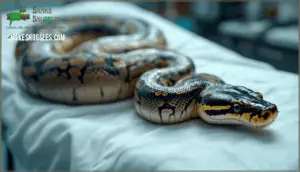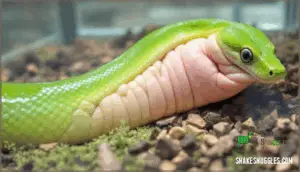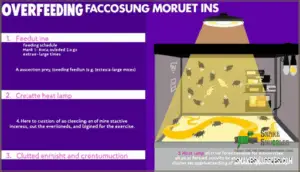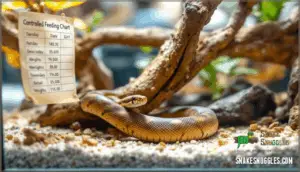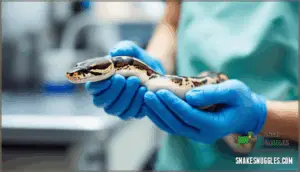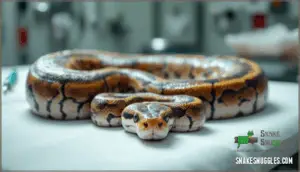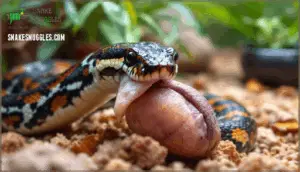This site is supported by our readers. We may earn a commission, at no cost to you, if you purchase through links.
 A snake’s natural feeding response can work against it in captivity. Wild snakes must hunt for unpredictable meals, but captive snakes receive regular feedings that can exceed their metabolic needs.
A snake’s natural feeding response can work against it in captivity. Wild snakes must hunt for unpredictable meals, but captive snakes receive regular feedings that can exceed their metabolic needs.
This difference leads many snake owners to accidentally overfeed their pets, causing obesity and serious health complications. Understanding proper feeding practices protects your snake from digestive stress, organ damage, and shortened lifespan.
Table Of Contents
- Key Takeaways
- How Snakes Digest Prey
- Risks of Overfeeding Snakes
- Signs of Overfeeding in Snakes
- Factors Contributing to Overfeeding
- Preventing Overfeeding in Snakes
- Managing Your Snake’s Weight
- Common Health Issues Caused by Overfeeding
- Snake Feeding Mistakes to Avoid
- Supplements and Vitamins for Snakes
- Adjusting Your Snake’s Feeding Schedule
- Frequently Asked Questions (FAQs)
- Can a snake eat something too big?
- What happens if a snake eats too much prey?
- Can a snake die from swallowing a prey too big?
- Do snakes eat Big prey?
- Can snakes choke if they eat too big?
- Why is my snake sluggish after a big meal?
- Why is my snake eating so much?
- What happens if you overfeed your snake?
- Why is my snake eating itself all the time?
- How often is too often to feed a snake?
- Conclusion
Key Takeaways
- Overfeeding snakes causes serious health complications including fatty liver disease, cardiovascular strain, respiratory compromise, and regurgitation risks that can significantly shorten their lifespan.
- Proper feeding schedules depend on your snake’s age—hatchlings need meals every 5–7 days, juveniles every 7–10 days, and adults only every 10–14 days—with prey size limited to 1.5 times the snake’s head width.
- Warning signs of overfeeding include visible abdominal swelling, stretched ventral scales showing fatty deposits, behavioral changes like lethargy and reduced exploration, and increased post-meal aggression.
- Prevention requires monitoring your snake’s weight monthly, maintaining appropriate enclosure enrichment for exercise, and adjusting feeding frequency based on body condition rather than appetite alone.
How Snakes Digest Prey
Your snake’s digestive system works differently than yours, built to cope with meals that seem impossibly large. Understanding how snakes break down prey helps you recognize when feeding goes from normal to dangerous.
Let’s look at the three key stages of snake digestion and what makes this process so extraordinary.
Unique Digestive System
A snake’s digestive system works like a high-powered chemical factory, built to break down entire animals—bones, fur, and all—in ways that would overwhelm most other predators. After swallowing prey whole, your snake’s stomach produces incredibly strong digestive enzymes in an acidic environment that rivals battery acid. This slow digestion process guarantees complete nutrient absorption:
- Powerful acids dissolve bones and teeth
- Specialized enzymes target proteins and fats
- Snake metabolism adjusts based on meal size
- Complete waste elimination occurs after several days
- The entire snake digestive system expands during feeding
Expanding to Digest Large Prey
Once your snake’s acid bath starts working, its body performs an equally impressive feat—the entire digestive tract stretches like a rubber band to accommodate prey that looks impossibly large. This expansion relies on impressive jaw flexibility and ribcage mobility working together. Your snake’s jaw structure allows independent movement of each bone, while skin elasticity permits the body to stretch around bulky meals without tearing.
| Anatomical Feature | How It Works | Purpose |
|---|---|---|
| Jaw Flexibility | Lower jaw bones separate at chin | Allows prey wider than head to enter |
| Esophageal Expansion | Muscular tube stretches 3-4 times normal diameter | Moves large prey toward stomach |
| Ribcage Mobility | Ribs spread outward and shift position | Creates space for bulky meals |
| Skin Elasticity | Stretchy scales between ventral plates | Accommodates temporary body expansion |
| Digestive Adaptations | Organs shift and compress temporarily | Prevents internal damage during feeding |
These snake feeding mechanisms represent millions of years of evolution in snake anatomy and physiology. However, even these impressive digestive adaptations have limits—prey exceeding 1.5 times your snake’s head width can overwhelm this system and cause regurgitation or internal injury.
Breaking Down Bones and Muscles
After your snake’s body expands to accommodate its meal, the real chemical warfare begins—gastric acids strong enough to dissolve bone start their work on everything from muscle tissue to skeletal structures. Digestive enzymes secreted from specialized cells attack protein bonds in muscles first, breaking down soft tissue within days.
The bone digestion process takes longer, as highly acidic gastric fluids with pH levels around 1.5 gradually dissolve calcium from skeletal structures.
Your snake’s metabolism ramps up during this process, increasing oxygen demands by up to 700% to fuel nutrient absorption through the intestinal wall, while waste elimination removes indigestible remnants like fur or feathers.
Risks of Overfeeding Snakes
Overfeeding your snake creates serious health problems that can shorten its lifespan. The consequences go beyond a bit of extra weight—they affect your snake’s organs, breathing, and ability to digest food properly.
Here are the main risks you need to watch for.
Obesity and Organ Dysfunction
Overfeeding creates a dangerous cascade of organ dysfunction in snakes. Hepatic lipidosis—fatty liver disease—develops when excess fat accumulates in liver cells, progressively impairing function and potentially causing liver failure. Obesity also strains the cardiovascular system, increasing atherosclerosis risk and heart disease. Long-term overnutrition contributes to renal disease, while reproductive impacts include follicular stasis in females. Fat accumulation around the spinal cord causes neurological deficits, reducing mobility and injury resilience. Studies show whole-body fat content in obese snakes reaches 42.8% dry matter versus 2.3% in healthy individuals. Snakes are also susceptible to developing heart disease due to obesity.
- Hepatic lipidosis reduces liver function and can progress to organ failure if untreated
- Cardiovascular strain from excess weight increases atherosclerosis and heart disease risk
- Renal and reproductive compromise impairs kidney function and breeding capacity while neurological deficits reduce locomotor ability
Respiratory Problems
When excess weight settles on your snake’s body, it doesn’t just affect how it looks—it starts crowding the space your snake needs to breathe. Extra fat deposits compress the lungs and air sacs, forcing your snake to work harder for each breath. Combined with poor enclosure ventilation or humidity levels that are too high, this creates serious respiratory compromise.
Your snake may display breathing difficulty, wheezing, or open-mouth breathing. In severe cases, aspiration pneumonia or lung infections develop when food particles enter the respiratory tract during feeding. These conditions require immediate veterinary care.
| Warning Sign | What It Means | Action Required |
|---|---|---|
| Open-mouth breathing | Respiratory distress | Contact a vet immediately |
| Wheezing or hissing sounds | Possible lung infection | Schedule veterinary exam |
| Lethargy and reduced activity | Respiratory compromise | Adjust feeding and environment |
| Mucus around mouth/nose | Aspiration pneumonia risk | Seek emergency care |
Monitor your snake’s weight regularly and maintain proper enclosure ventilation to prevent respiratory health complications.
Digestive Issues and Regurgitation
Regurgitation often stems from prey that’s too large or picking up your snake too soon after feeding. When your snake eats a meal exceeding 25% of its body mass, gastric emptying takes considerably longer, overwhelming its digestive system. Picking it up within 48–72 hours post-feeding increases regurgitation risk by up to 50%.
Chronic regurgitation develops when feeding intervals are too short, disrupting the digestive cycle and creating gut microbiota imbalances. This condition promotes parasitic infections and bacterial proliferation, such as Salmonella. Overfeeding can also lead to serious digestive problems, further exacerbating these issues.
To prevent these complications, space feedings according to your snake’s digestive cycle, limit prey to less than 1.25 times your snake’s girth, and avoid picking it up for 48–72 hours after feeding.
Signs of Overfeeding in Snakes
Catching overfeeding early makes a real difference in your snake’s health. The good news is that your snake will show you clear warning signs when it’s eating too much.
Learning to spot these signs helps you adjust feeding habits before serious problems develop.
Abdominal Swelling
Your snake’s belly tells the story—a visibly swollen abdomen is one of the clearest signs that you’re feeding too much. When you palpate your snake gently, you might feel fluid buildup or excessive distension that shouldn’t be there. Imaging options like radiographs can reveal what’s happening internally, showing whether digestive issues stem from oversized prey or digestive blockages.
Abdominal swelling often indicates your snake’s digestive system is overwhelmed. Treatment plans depend on severity, but prevention through proper prey sizing works best. Watch for a rounded, bloated appearance along your snake’s midsection—that’s your cue to adjust feeding frequency and meal portions immediately.
Behavioral Changes
Behavioral shifts often follow large meals as your snake’s physiology adjusts to digestion. Post-meal aggression spikes within 12–48 hours, so avoid physical contact during this window. Simultaneously, reduced exploration and climbing decline sharply as oxygen consumption skyrockets and weight alters balance. Your snake seeks thermal zones to improve digestion, displaying sluggish activity and food refusal for days.
Observing snake actions patterns helps you catch overfeeding early:
- Reluctance to move or explore their enclosure
- Increased defensive striking when disturbed
- Preference for warm spots over normal activity
- Complete disinterest in offered prey for extended periods
These signs indicate digestive demands are taxing their system.
Ventral Scale Swelling
Stretched belly scales that appear separated or lighter in color signal your snake’s body is struggling to manage its meal size. This scale appearance change reveals fatty deposits pushing outward beneath the skin. Swelling causes include oversized prey or too-frequent feeding.
Identifying swelling involves monitoring body condition weekly—check for fatty bulges along the lower third of the body.
Treatment options require adjusting portion sizes immediately.
Preventing swelling means recognizing signs of overfeeding before permanent damage occurs.
Factors Contributing to Overfeeding
Overfeeding doesn’t happen by accident. Three factors play the biggest role in whether your snake gets too much food: how often you feed, what size prey you offer, and your snake’s age and metabolism.
Let’s look at each one so you can keep your feeding routine on track.
Feeding Frequency
Think of feeding frequency like a metronome—timing matters more than most keepers realize. Age-based schedules form the foundation: hatchlings need meals every 5-7 days to support rapid growth, while adults thrive on 10-14 day intervals. Species variations also play a role—ball pythons and corn snakes follow different metabolic patterns.
Environmental factors significantly impact appetite. Cooler temperatures slow digestion, and activity levels naturally suppress snake appetite during shedding cycles. These signals indicate when to adjust your snake feeding schedule. Following proper snake feeding guidelines is crucial to prevent the health issues that overfeeding can trigger.
- Match feeding frequency to your snake’s age and metabolism
- Adjust snake diet timing during shedding cycles
- Consider species-specific snake feeding needs
- Monitor how environmental temperature affects digestion
- Track activity levels to improve your schedule
Prey Size and Type
Once you’ve locked down the timing, choosing prey that matches your snake’s body width becomes the next safeguard against overfeeding complications. Prey Size Guidelines recommend items no wider than 1.5 times your snake’s widest point. Oversized prey triggers regurgitation or blockages—even one meal can cause harm.
Pay attention to prey width and prey weight together. Live vs Frozen options both work if the appropriate prey size fits. Offering Variety improves Prey Nutritional Value and prevents deficiencies. When Sourcing Prey Ethically, confirm measurements before purchasing.
| Prey Type | Selection Factor |
|---|---|
| Mice/Rats | Match body girth, not head size |
| Frozen Options | Measure thawed width accurately |
| Varied Species | Rotate for nutritional balance |
| Weight Check | Avoid items exceeding 10-15% snake weight |
| Growth Stage | Adjust as your snake matures |
Snake Age and Size
As your snake matures from hatchling to adult, its metabolic demands shift dramatically, and matching food to these life stages prevents both malnourishment and dangerous overfeeding. Hatchling feeding requires meals every 5-7 days since rapid growth stages burn energy fast. Juvenile snakes need food every 7-10 days as growth slows. Adult frequency drops to 10-14 days because mature snakes maintain rather than build mass. Species variation matters—ball pythons reach adult size slower than corn snakes, affecting age and size considerations throughout their lives.
Track these shifts:
- Monitor body condition monthly to catch weight changes early
- Adjust prey size as girth increases during growth stages
- Recognize species-specific needs based on natural metabolism rates
- Reduce hatchling frequency gradually as your snake approaches adult proportions
Size impact affects digestion capacity more than appetite alone.
Preventing Overfeeding in Snakes
Preventing overfeeding requires a structured approach that considers when you feed, what you offer, and how you maintain your snake’s activity level.
The following strategies work together to create a feeding routine that fosters healthy growth without excess weight gain.
These practical steps help you avoid the complications that come from overfeeding while meeting your snake’s nutritional needs.
Proper Feeding Schedules
Getting the timing right can mean the difference between a thriving snake and one that’s headed for trouble. Age-based schedules form the foundation of proper snake feeding guidelines. Hatchlings need meals every 5-7 days to support rapid growth, while adults usually eat every 1-2 weeks.
Species-specific needs matter too—ball pythons and corn snakes have different requirements. Factor in prey digestion time, which usually takes 2-4 days depending on meal size.
Seasonal adjustments help mimic natural patterns, with some snakes eating less during winter. Consistent schedules prevent overfeeding and keep your snake healthy long-term.
Prey Selection and Portion Control
Picking the right prey isn’t just about tossing a mouse into the tank and hoping for the best. Your snake’s health depends on matching prey size to its body width and understanding nutritional balance. Follow these snake feeding guidelines:
- Prey size: Select prey no wider than 1.5 times your snake’s midsection
- Feeding frequency: Adjust based on age and species requirements
- Prey variety: Rotate between mice and rats for balanced snake nutrition
- Portion control: One appropriately sized meal prevents overfeeding complications
Encouraging Exercise and Activity
Your snake’s enclosure shouldn’t be a static box—it needs to function as a fitness center that keeps your pet moving and burning calories. Add climbing opportunities like branches and varied terrain to promote mobility.
Enclosure enrichment prevents sluggish actions and reduced activity that often accompany overfeeding. Regular interaction and supervised exploration outside the enclosure provide enrichment activities that combat mobility impairment while keeping your snake lean and healthy.
Managing Your Snake’s Weight
Keeping your snake at a healthy weight isn’t guesswork—it requires consistent tracking and thoughtful adjustments. You’ll need to monitor physical changes, modify meal schedules when needed, and create opportunities for movement.
Here’s how to maintain your snake’s ideal body condition throughout its life.
Monitoring Weight Gain
Tracking weight changes over time gives you a reliable way to spot overfeeding before serious health problems develop. Use a digital scale designed for reptiles to conduct regular weigh-ins every two to four weeks. Record each measurement alongside the date to analyze your snake’s growth rate and detect rapid weight gain patterns.
Visual assessments complement weight tracking tools effectively:
- Check for fatty deposits along the spine and sides that signal snake obesity prevention needs
- Evaluate your snake’s body condition score by examining how rounded versus triangular the body appears
- Watch for skin stretching between scales that indicates excess weight accumulation
Monitoring body condition through both measurements and observation protects your snake’s long-term health.
Adjusting Feeding Schedules
When you notice your snake’s weight climbing or its activity dropping, it’s time to recalibrate how often you’re offering meals. Juvenile snakes usually need food every 5-7 days, but adult frequency shifts to every 10-14 days as growth slows. Age-based adjustments matter because metabolic rates change throughout your snake’s life.
Seasonal variations also affect appetite—many species eat less during winter months. During shedding periods, skip meals entirely to avoid regurgitation. If your snake’s breeding or showing weight gain between the scales, extend feeding frequency by several days until body condition improves.
Encouraging Physical Activity
Think of your snake’s enclosure as its gym—without the right setup, it’ll never break a sweat. Install branches for climbing opportunities and add varied terrain like bark or sand to stimulate foraging instincts.
Enclosure enrichment—including hide boxes placed at different heights—combats sluggish instincts and reduced activity. Supervised exploration outside the enclosure boosts mobility while preventing the weight-related mobility impairment that comes from sedentary living.
Common Health Issues Caused by Overfeeding
Overfeeding doesn’t just make your snake pudgy—it triggers a cascade of health problems that can seriously compromise their well-being. From skin infections to dangerous digestive complications, excess food puts strain on multiple body systems at once.
Here’s what you need to watch for when your snake’s been eating more than it should.
Skin Problems and Infections
Overfeeding doesn’t just create bulges—it opens the door to serious skin infections. When your snake carries excess weight, it becomes more vulnerable to bacterial infections and fungal infections, particularly scale rot.
Studies show that 27% of snake injuries lead to infections, with gram-negative bacteria comprising 63% of isolated pathogens. Poor ventilation and humidity create perfect breeding grounds for these invaders, increasing infection susceptibility and health complications like pneumonia.
Diagnostic approaches using PCR can detect lesion severity early, helping you catch health risks before they escalate.
Rapid Weight Gain
A snake that balloons up too fast is like a ticking time bomb—rapid weight gain isn’t just cosmetic, it’s a red flag for serious health trouble. Overfeeding triggers fatty deposits along your snake’s body, creating visible bulges that signal poor appetite control and compromised body condition.
Watch for these warning signs:
- Fatty deposits appearing between scales and around the spine
- Reduced basking as excess weight limits movement
- Lethargic actions during feeding time
- Distorted body condition with thickened midsections
Dietary adjustments are essential to prevent permanent damage.
Regurgitation and Digestive Issues
If rapid weight gain sets the stage for trouble, regurgitation is often the opening act—spitting up meals signals your snake’s digestive system has hit its limit. Causes of regurgitation include oversized prey, stress, or handling too soon after feeding. Digestive blockages and impaction create dangerous complications requiring immediate veterinary care.
| Issue | Primary Cause | Prevention Strategy |
|---|---|---|
| Regurgitation | Prey exceeding digestive capacity | Match prey to snake’s girth |
| Digestive complications | Excessive feeding frequency | Space meals 7-14 days apart |
| Impaction | Ingesting substrate with prey | Feed in separate container |
| Rotting prey internally | Oversized meals | Watch post-feeding activity closely |
Treating regurgitation requires fasting for 10-14 days before reintroducing smaller prey.
Snake Feeding Mistakes to Avoid
Even experienced snake keepers slip up regarding feeding. Getting the basics right means avoiding three common pitfalls that can harm your snake’s health. Let’s look at what not to do.
Overfeeding and Underfeeding
Getting the feeding formula right is like walking a tightrope—too much food on one side, too little on the other, and your snake pays the price either way. Overfeeding leads to obesity and organ strain, while underfeeding causes nutritional deficiencies and shedding issues. Watch for signs of overfeeding like rapid growth rate beyond ideal bodyweight. Balance prevents both extremes:
- Match prey variety to your snake’s size.
- Track weight monthly.
- Adjust meals as needed.
Poor Prey Quality and Presentation
You wouldn’t feed your family spoiled groceries, so why would you offer your snake anything less than fresh, properly treated prey? Poor prey quality causes nutritional deficiencies and digestive problems.
Source prey items from reputable suppliers and check for signs of spoilage. Use proper thawing methods—never microwave frozen prey.
Gut loading enriches prey variety with essential nutrients. Presentation techniques matter too: offering prey at the right temperature encourages natural feeding responses and promotes snake nutrition.
Inadequate Feeding Frequency
Inconsistent feeding schedules create more problems than missing a single meal. Hatchlings require meals every 5-7 days to support rapid growth, while adults thrive on 1-2 week intervals. Skipping feedings triggers metabolic slowdown and growth stunting, weakening immune suppression over time.
Conversely, feeding too frequently—say, offering prey every 3 days to an adult—leads to overfeeding and obesity. Behavioral changes like increased aggression or lethargy signal something’s off.
Proper feeding frequency and portion control prevent nutritional deficiencies while supporting healthy appetite control in your snake feeding routine.
Supplements and Vitamins for Snakes
Most snakes get everything they need from whole prey, but certain situations call for extra support. Calcium and vitamin D3 become especially important if you’re feeding frozen-thawed prey or caring for a snake with specific health concerns.
Let’s look at when supplements matter and how to use them without creating new problems.
Importance of Calcium and Vitamin D3
Calcium and vitamin D3 form the foundation of skeletal health in snakes. Your snake needs calcium for strong bones and proper muscle function, while vitamin D3 facilitates calcium absorption in the intestines. Without this duo, metabolic bone disease develops—causing fractures, deformed bones, and impaired movement.
Here’s what these nutrients do for your snake:
- Calcium absorption depends entirely on adequate vitamin D3 levels
- MBD prevention requires a 2:1 calcium-phosphorus ratio for healthy mineralization
- Dietary sources like whole prey (bones included) generally meet requirements
- Vitamin D3 synthesis occurs naturally through UV-B exposure
- Mineral composition in healthy snakes averages 54.73 g/kg calcium content
Whole prey diets generally provide sufficient nutrition, reducing supplementation needs. However, if your snake shows soft bones or reduced activity, veterinary care becomes essential to address potential health risks before complications worsen.
Administering Supplements Safely
Proper supplement administration requires the same precision as choosing prey size—a careful balance prevents deficiencies without causing toxicity. Dosage accuracy matters most when applying supplements. Lightly dust prey items with calcium powder rather than coating them heavily. Supplement forms vary—powders work better than liquids for most situations. Mixing supplements without vet consultation risks harmful imbalances.
Your reptile health depends on balanced diet management and veterinary care guidance for snake diet and nutrition decisions.
| Supplement Practice | Safe Approach |
|---|---|
| Dosage frequency | Once weekly for adults |
| Application method | Light dusting on prey |
| Storage conditions | Cool, dry, sealed container |
| Expiration monitoring | Replace every 6 months |
| Safe handling | Avoid direct moisture contact |
Adjusting Your Snake’s Feeding Schedule
A snake’s feeding schedule isn’t set in stone. Your snake’s needs will change as it grows, and keeping track of what you feed and when helps you spot patterns before problems develop.
Let’s look at three key ways to fine-tune your feeding approach.
Tracking Feeding Frequency and Amount
Detailed feeding logs transform guesswork into precision when preventing overfeeding. Recording each meal gives you a clear picture of your snake’s nutritional patterns and helps catch problems early.
Track these four essentials in your feeding log:
- Meal size and prey weight: Document exact prey dimensions to maintain proper portion control.
- Feeding frequency: Mark each feeding date to guarantee consistent snake feeding schedules.
- Growth monitoring: Weigh your snake monthly to detect rapid weight gain.
- Caloric intake patterns: Note prey type variations to balance nutrition and prevent overfeeding.
This systematic approach to adjusting feeding frequency protects your snake’s long-term health.
Adjusting Feeding Schedules Based on Snake Age
Your snake’s age dictates how often it needs to eat, and getting this timing wrong can tip the scales toward health problems. Hatchlings need meals every five to seven days to fuel rapid growth, while juveniles thrive on weekly feedings with appropriately sized portions. Adults require feeding only every ten to fourteen days, and senior snakes with slower metabolisms may stretch these intervals even further.
During brumation, pause feeding entirely until your snake becomes active again.
Monitoring Snake Health
Regular health monitoring acts as your early warning system, catching potential problems before they escalate into serious complications. Track your snake’s weight monthly using a digital scale to spot gradual increases that signal overfeeding. Watch shedding patterns closely—incomplete sheds often indicate hydration levels are off. Demeanor observation matters too: lethargy or reduced activity suggests digestive struggles.
Check the enclosure regularly for proper humidity and temperature, since these factors directly affect snake digestion.
Schedule veterinary care annually, and consult your vet immediately if regurgitation or rapid weight gain occurs.
Frequently Asked Questions (FAQs)
Can a snake eat something too big?
Snakes can absolutely consume prey that’s too large for their bodies. While their jaws unhinge to accommodate substantial meals, there’s still a limit.
Prey exceeding 5 times the snake’s head width creates serious ingestion risks, including regurgitation dangers and esophageal damage. Oversized prey can lead to impaction risks, internal blockages, and even fatal complications despite a snake’s impressive swallowing abilities.
What happens if a snake eats too much prey?
When a snake’s appetite outpaces good judgment, the consequences can be severe. Overfeeding triggers regurgitation risks, obesity effects, and digestive complications that stress your snake’s system.
Internal injuries may occur, while immune suppression leaves your pet vulnerable to infections and respiratory distress.
Can a snake die from swallowing a prey too big?
Yes. When a snake attempts to swallow oversized prey, asphyxiation and respiratory compromise can occur during ingestion. Digestive blockages, internal injuries, and regurgitation risks follow if the prey exceeds safe dimensions.
Snake anatomy limits what can pass safely through the digestive tract, making prey size matters critical for survival.
Do snakes eat Big prey?
Like a python unhinging its jaw to swallow a gazelle whole, snakes excel at consuming prey larger than their heads. They can safely manage meals up to one and a half times their head width, thanks to flexible jaws and expandable skin.
However, oversized prey poses serious dangers including regurgitation, internal injuries, and digestive blockages that can prove fatal.
Can snakes choke if they eat too big?
Although it’s rare, oversized prey can create breathing obstruction. The trachea stays open during swallowing, but extremely large meals may press against it and cause respiratory distress in snakes.
Why is my snake sluggish after a big meal?
After eating, your snake slows down dramatically—but this isn’t laziness. Digestion consumes massive amounts of energy, temporarily shutting down other body functions. Your snake redirects blood flow to its digestive system, raising its core temperature through basking actions to speed up the snake digestion process.
This metabolic demand leaves it vulnerable and sluggish, sometimes for days. Proper hydration levels and environmental factors like temperature directly affect digestion efficiency, so don’t pick up your snake during this critical recovery period.
Why is my snake eating so much?
If your snake seems constantly hungry, it’s not always about poor feeding habits. Young snakes experience rapid growth spurts that increase their dietary needs considerably.
Environmental factors like temperature fluctuations can also affect metabolism and perceived hunger, making your snake more food-motivated than usual.
What happens if you overfeed your snake?
Imagine finding your ball python unable to move after swallowing an oversized rat—that’s when overfeeding stops being harmless. When you overfeed your snake, regurgitation risks increase dramatically, often damaging the esophagus and causing internal injuries.
Obesity effects include organ dysfunction and respiratory distress as excess fat compresses essential systems. Digestive complications like impaction can prove fatal, while immunity weakening opens the door to infections.
These health consequences demand immediate veterinary attention to prevent long-term damage.
Why is my snake eating itself all the time?
This action, called self-cannibalism, usually stems from stress-induced eating, poor enclosure size, or overheating that confuses your snake’s feeding response.
Check temperature gradients and humidity levels immediately. If tail-biting persists, consult a reptile veterinarian to rule out neurological issues or genetic predisposition requiring intervention.
How often is too often to feed a snake?
Daily meals strain your snake’s system. The best frequency varies by species and age—hatchlings need food every 5-7 days, while adults thrive on 10-14 day intervals. Activity levels and shedding cycles also influence feeding practices.
Conclusion
A veterinary hospital recently treated a ball python with severe obesity after its owner fed weekly meals for three years—double the recommended frequency. The snake developed fatty liver disease and required months of dietary rehabilitation.
Your snake eating too much isn’t just about extra weight. It triggers cascading health problems that compromise organ function and lifespan.
Monitor your snake’s body condition regularly, adjust prey size to match growth stage, and resist the urge to feed outside your established schedule. These simple practices prevent the metabolic damage that shortens your pet’s life.
- https://www.telegraph.co.uk/news/2023/11/24/fat-pet-snakes-obesity-problem-uk/
- https://www.reddit.com/r/snakes/comments/lz8acl/the_increasingly_exaggerated_danger_of_feeding/
- https://www.niu.edu/clas/biology/_pdfs/rking/Jones_et_al_2009.pdf
- https://www.sciencedirect.com/science/article/abs/pii/S0031938410003173
- https://www.sciencenews.org/blog/wild-things/python-every-meal-thanksgiving

